Application of Electron Probe Microanalyzer to Study the Textures and Compositions of Alteration Coronas of Monazite from the Longhuashan Granite, Northern Guangdong Province
-
摘要: 独居石是华南产铀花岗岩中常见的含铀副矿物。龙华山岩体是粤北诸广山复式岩体中一个重要的产铀花岗岩,该岩体的独居石具有蚀变晕圈现象。但是,该岩体中独居石蚀变晕圈的结构和成分特征以及对铀成矿的指示意义尚未开展研究。本文利用电子探针(EPMA)对龙华山岩体的独居石蚀变晕圈开展结构和成分研究。测试结果表明:独居石蚀变晕圈是从内到外由独居石、磷灰石(包括富钍矿物)和褐帘石-绿帘石构成的同心环带。质量平衡计算表明独居石在蚀变过程中,轻稀土(LREE)、Y、Th和U等元素发生活化迁移,流体带入Ca、Fe、Al、F等元素,形成了由磷灰石、褐帘石、绿帘石和富钍矿物组成的蚀变晕圈。EPMA面扫描图像显示独居石蚀变导致了铀发生活化,但铀主要在蚀变晕圈中富集。研究数据显示龙华山岩体中仅3.7%的铀赋存于独居石中,而80%以上的铀赋存在晶质铀矿中。本研究表明独居石对区域铀矿化贡献的成矿物质有限,晶质铀矿是龙华山岩体最重要的铀源矿物。要点
(1) 利用电子探针揭示了龙华山岩体中独居石蚀变晕圈的结构与成分特征。
(2) 质量平衡计算得出独居石部分蚀变释放REE、Th、U,而Ca、Fe等元素被流体带入形成蚀变晕圈。
HIGHLIGHTS(1) Textures and compositions of alteration coronas of monazite from the Longhuashan granite were investigated using electron probe microanalyzer (EPMA).
(2) Mass balance calculation suggested that REE, Th, and U were released from monazite alteration, while Ca, Fe and other elements were introduced by fluids to form alteration coronas.
Abstract:BACKGROUNDMonazite is a common uranium-bearing accessory mineral in granite-related uranium deposits in South China. The Longhuashan pluton is an important U-bearing granite in the Zhuguangshan batholith, Northern Guangdong. Distinct alteration coronas of monazite were observed in the pluton. However, textures and compositions of alteration coronas of monazite and their implications for uranium mineralization are still poorly understood.OBJECTIVESTo investigate the detailed textural and compositional evolution of monazite in granites during alteration, and to provide insights into uranium mobilization and enrichment in granite-related uranium deposits.METHODSTextures and chemical compositions of alteration coronas of monazite were investigated using electron probe microanalyzer (EPMA).RESULTSAlteration coronas of monazite in the Longhuashan granite consisted of newly formed apatite, allanite, epidote, and Th-rich phases. The monazite alteration coronas area was a concentric zone composed of monazite, apatite (including thorium-rich minerals), and monazite-epidote from the inside to the outside. Mass balance calculations showed that during the alteration of monazite, light rare earth (LREE), Y, Th, and U elements were remobilized and migrated, and the fluid brought in elements such as Ca, Fe, Al, and F to form alteration coronas composed of apatite, epidote, and thorium-rich minerals. The EPMA mapping showed that monazite alteration led to the remobilization of uranium, but the uranium was mainly enriched in the altered coronas. In this pluton, 3.7% U was located in monazite, and more than 80% U was hosted by uraninite.CONCLUSIONSMonazite only contributes limited uranium to regional uranium mineralization, and uraninite is the most important host for uranium in the Longhuashan granite.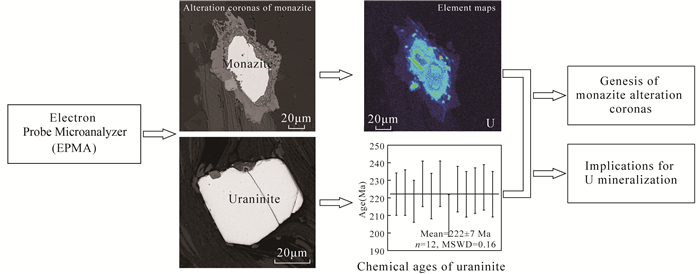
-
独居石是过铝质花岗岩中常见的富轻稀土元素(LREE)磷酸盐矿物,它所含的LREE含量常常是寄主岩石LREE总量的40%~80%[1]。独居石还可以含有大量的Th和U含量。例如意大利Monte Capanne岩体中独居石的ThO2含量可达42.82%,UO2含量可达2.19%[2];德国Fichtelgebirge花岗岩中独居石的ThO2含量高达21.20%,UO2含量高达8.02%[3];中国广西豆乍山岩体中独居石的UO2含量可达1.68%[4]。独居石是有效的定年矿物[5-7],并且常常被认为是形成热液铀矿床重要的铀源提供者[4, 8-11]。大多数热液铀矿床是后生热液成因,因此,只有当独居石发生蚀变导致铀发生活化迁移,才可以成为有效铀源[4, 9]。理解独居石在蚀变过程中详细的结构特征和成分变化对解译铀成矿过程具有重要意义。
独居石是华南产铀花岗岩中常见的含铀副矿物,因其常含有较高的铀含量而被认为是铀源矿物[4, 10-11]。例如,广西豆乍山花岗岩中独居石的UO2含量为0.98%~1.68%,独居石蚀变形成直氟碳钙铈矿,从而铀被释放,为铀成矿提供铀源[4]。粤北长江产铀花岗岩中独居石的UO2含量为0.27%~0.73%,ThO2含量为2.40%~5.89%,是该岩体的铀源矿物[10]。独居石在流体作用下发生蚀变的机制主要有两种:①独居石被其他矿物替代,蚀变产物主要是磷灰石、褐帘石和绿帘石;②形成次生独居石,与原生独居石具有不同的结晶年龄和成分等特征[12-19]。华南产铀花岗岩中的独居石在流体作用下可形成蚀变晕圈现象[20],但是独居石蚀变晕圈的结构和成分特征研究较为薄弱。此外,形成蚀变晕圈现象的独居石对区域铀成矿是否贡献铀源也需要开展进一步研究。
粤北诸广山地区是中国最重要的花岗岩型铀矿床聚集地之一,区内产有302、305、308、201等多个大中型花岗岩型铀矿床。诸广山岩体是一个主要由加里东期、印支期和燕山期花岗岩组成的复式岩体,区内铀矿化与印支期花岗岩关系最为密切[20-23]。龙华山岩体是该复式岩体中一个重要的印支期产铀花岗岩。本项目组在研究诸广山岩体的晶质铀矿矿物学特征过程中发现该岩体中独居石具有独特的蚀变晕圈现象[20],然而组成蚀变晕圈的矿物尺寸较小(一般为1~100μm),部分矿物无法利用激光剥蚀-电感耦合等离子质谱仪等仪器获取其成分特征,这为揭示独居石蚀变晕圈成因带来挑战。电子探针(EPMA)具有高空间分辨率(束斑可小至1μm)、方便快速、可进行微区原位分析等优点[24],是研究独居石蚀变晕圈的有效工具。例如,Broska等[14]利用EPMA获得斯洛伐克Western Carpathians岩体中独居石蚀变晕圈的结构和矿物化学,指出独居石蚀变晕圈是流体作用的结果;胡欢等[4]利用EPMA获取了豆乍山岩体中独居石及其蚀变产物直氟碳钙铈矿的化学成分,从而揭示了独居石是该岩体重要的铀源矿物。本文利用EPMA对龙华山岩体中独居石蚀变晕圈的结构和矿物化学进行分析,以探讨独居石蚀变晕圈成因以及对铀成矿的指示意义。
1. 研究区概况
诸广山岩体(图 1)呈巨型岩基产出,总出露面积大于2500km2,是一个主要由加里东期(420~435Ma)、印支期(225~240Ma)和燕山期(150~165Ma)花岗岩组成的复式花岗岩体[21-23, 25]。该复式岩体被北东向南雄断裂带和热水-遂川断裂带所夹持[26]。区内发育北东向、北西向和近东西向基性岩脉,成岩年龄集中在~140Ma、~105Ma和~90Ma[27]。龙华山岩体南部是南雄盆地,该盆地的形成与盆地-山体系统演化主要由诸广山花岗岩穹隆和区域伸展构造控制[28],对邻近区域铀矿床如棉花坑和书楼坵的形成起到重要作用[29]。诸广山地区是中国重要的花岗岩型铀矿床聚集地,该地区产有多个铀矿田,如长江、百顺、城口[30]。这些铀矿床多产于花岗岩区域内北东向主干断裂附近以及伴生的次级硅化碎裂带中,铀矿石矿物以沥青铀矿为主,成矿年龄集中于110~50Ma[26, 31-32],成矿温度集中在120~260℃,盐度一般小于10% NaCleqv[29]。龙华山岩体位于诸广山复式岩体的东南端,出露面积约265km2,该岩体产有231铀矿床(图 1),是该地区的一个重要产铀花岗岩。该岩体主要由黑云母花岗岩组成,锆石U-Pb年龄为225.0±2.7Ma,铝饱和指数(A/CNK)为1.08~1.27,铀含量为10.7~44.7μg/g(平均值为27.8μg/g),岩石地球化学表明该岩体属于S型花岗岩[20, 23]。
2. 实验部分
2.1 样品采集及处理
本次研究所用样品采自龙华山岩体的地表露头和钻孔岩心。样品主要由石英(35%~40%)、钾长石(30%~35%)、斜长石(25%~30%)、黑云母(5%~8%)和少量白云母(<2%)等矿物组成。选取代表性样品磨制成EPMA薄片,然后对薄片进行EPMA背散射观察、成分测试以及元素面扫描分析。
2.2 样品分析测试
EPMA分析在中国地质科学院矿产资源研究所EPMA实验室完成。采用日本电子JOEL公司生产的JXA-8230电子探针对样品进行微区观察与定量分析,定量分析测试条件为:加速电压15kV,束流20nA,束斑大小1~5μm[24]。所用标准样品和分光晶体为:硬玉(Na:TAP;Al:TAP;Si:PETJ);镁橄榄石(Mg:TAP);黄玉(F:TAP);硅灰石(Ca:PETH);赤铁矿(Fe:LIF);磷灰石(P:PETJ);UO2(U:PETH);PbCO4(Pb:PETH);ThO2(Th:PETH)。稀土元素标样为合成稀土五磷酸盐。元素面扫描分析所用测试条件为:加速电压15kV,束流100nA,停留时间50ms。
3. 结果与讨论
3.1 独居石蚀变晕圈特征及成因
3.1.1 独居石蚀变晕圈结构与成分特征
龙华山岩体岩性为黑云母花岗岩(图 2a),岩体中独居石颗粒大小为50~150μm,呈半自形至自形。背散射图像显示位于造岩矿物颗粒之间的独居石常常具有蚀变晕圈结构,由内到外可分为独居石带、磷灰石带、褐帘石-绿帘石(图 2中b~f)。①独居石带:独居石位于蚀变晕圈的中心,一些独居石含有锆石和钍石包体(图 2b);②磷灰石带:该带位于蚀变晕圈的幔部,磷灰石保留着独居石的原始形状,这说明磷灰石可能直接替代独居石。磷灰石中含有许多微小矿物包体,能谱分析显示该包体是富钍矿物,一些富钍矿物呈细脉状充填于最外带的褐帘石和绿帘石中(图 2c),甚至造岩矿物颗粒边界(图 2d);③褐帘石-绿帘石带:该带位于蚀变晕圈最外部,在背散射图像中该带具有不同的背散射强度,即具有明显明暗变化(图 2中b~d)。能谱与EPMA分析显示明亮区域为褐帘石成分,暗色区域为绿帘石,褐帘石与绿帘石的空间分布无明显规律。一些独居石与锆石共生,靠近锆石一端未出现蚀变晕圈(图 2e)。图 2f显示,该独居石颗粒部分包裹于磷灰石中,而没有被磷灰石包裹的下端部分发生了蚀变。
![]() 图 2 龙华山岩体手标本和独居石蚀变晕圈照片a—钻孔岩心照片;b~d—独居石(Mnz)蚀变晕圈背散射照片,独居石被磷灰石(Ap)、富钍矿物、褐帘石(Aln)和绿帘石(Ep)部分替代;e—与锆石(Zrn)共生的独居石,靠近锆石一侧未出现蚀变晕圈现象;f—部分包裹于磷灰石中的独居石。Figure 2. Photographs of hand specimen samples and alteration coronas of monazite from the Longhuashan granite. a—Hand specimen photographs of samples collected from drill cores within the Longhuashan granite; b, c, d—Backscattered electron images of monazite (Mnz) alteration coronas consisting of apatite (Ap), Th-rich minerals, allanite (Aln), and epidote (Ep); e—Monazite alteration coronas showing no alteration coronas near zircons (Zrn); f—Monazite partly enclosed in apatite
图 2 龙华山岩体手标本和独居石蚀变晕圈照片a—钻孔岩心照片;b~d—独居石(Mnz)蚀变晕圈背散射照片,独居石被磷灰石(Ap)、富钍矿物、褐帘石(Aln)和绿帘石(Ep)部分替代;e—与锆石(Zrn)共生的独居石,靠近锆石一侧未出现蚀变晕圈现象;f—部分包裹于磷灰石中的独居石。Figure 2. Photographs of hand specimen samples and alteration coronas of monazite from the Longhuashan granite. a—Hand specimen photographs of samples collected from drill cores within the Longhuashan granite; b, c, d—Backscattered electron images of monazite (Mnz) alteration coronas consisting of apatite (Ap), Th-rich minerals, allanite (Aln), and epidote (Ep); e—Monazite alteration coronas showing no alteration coronas near zircons (Zrn); f—Monazite partly enclosed in apatite龙华山岩体中独居石蚀变晕圈矿物(独居石、磷灰石、绿帘石、褐帘石)和晶质铀矿代表性EPMA分析结果见表 1。独居石主要由P2O5(27.96%~30.62%)、轻稀土元素(La2O3+Ce2O3+Pr2O3+Nd2O3+Sm2O3=48.91%~61.39%)和ThO2(4.66%~10.96%)组成,含有少量的CaO(0.24%~2.25%)、SiO2(0.14%~1.11%)和Y2O3(0.93%~2.20%)。独居石的UO2含量为0.05%~0.47%。磷灰石主要由P2O5(32.06%~36.01%)和CaO(42.29%~46.07%)组成,含有较高的ThO2(8.35%~12.13%)。
表 1 龙华山花岗岩中独居石蚀变晕圈矿物(包括独居石、磷灰石、绿帘石、褐帘石)和晶质铀矿代表性电子探针分析结果Table 1. Representative EPMA chemical compositions of monazite alteration coronas (including monazite, apatite, epidote, and allanite) and uraninite from the Longhuashan granite矿物 独居石(%) 磷灰石(%) 绿帘石(%) 褐帘石(%) 晶质铀矿(%) 点1 点2 点3 点1 点2 点1 点2 点3 点1 点2 点3 点1 点2 点3 CaO 1.38 0.47 2.25 42.29 46.07 16.38 16.78 15.61 10.89 11.83 12.76 0.00 0.01 0.00 P2O5 29.50 29.10 30.60 32.06 36.01 0.00 0.00 0.00 0.00 0.00 0.00 0.00 0.00 0.00 ThO2 9.23 8.53 10.00 12.13 8.35 0.00 0.10 0.00 0.18 0.14 0.14 1.01 1.16 1.06 La2O3 12.03 11.23 10.67 0.26 0.05 1.76 1.50 2.13 3.76 5.12 5.65 0.00 0.00 0.02 Ce2O3 24.32 26.02 22.78 0.62 0.47 6.25 7.75 7.41 12.75 11.36 11.09 0.11 0.00 0.00 Nd2O3 7.50 7.72 6.97 0.29 0.27 0.97 0.88 1.08 2.89 2.68 1.36 0.00 0.02 0.00 Pr2O3 7.17 8.66 7.27 0.73 0.48 1.55 1.12 1.42 2.93 2.56 2.51 0.00 0.02 0.06 Sm2O3 3.42 1.90 1.21 0.10 0.01 0.74 0.62 0.69 1.01 0.92 0.89 0.24 0.00 0.00 Dy2O3 2.41 1.51 2.58 0.37 0.00 0.47 0.81 0.54 0.71 0.58 0.81 0.00 0.00 0.00 Lu2O3 0.34 0.00 0.30 0.38 0.14 0.00 0.00 0.00 0.00 0.00 0.00 0.00 0.00 0.00 Y2O3 0.93 1.03 1.84 0.05 0.01 0.70 0.97 1.08 0.39 0.27 0.34 0.09 0.16 0.42 UO2 0.06 0.05 0.47 0.49 0.16 0.00 0.00 0.02 0.08 0.02 0.03 92.25 91.66 95.09 F 0.62 0.80 0.63 3.82 3.89 0.00 0.00 0.02 0.10 0.29 0.00 0.00 0.00 0.00 SiO2 0.73 1.03 0.40 3.63 2.54 33.57 32.88 33.77 31.68 31.87 32.05 0.00 0.00 0.04 Al2O3 0.00 0.00 0.00 0.00 0.00 21.76 21.63 21.76 18.05 19.31 19.68 0.00 0.00 0.00 FeO 0.00 0.00 0.00 0.00 0.00 9.40 8.83 9.49 11.74 10.83 10.14 0.09 0.00 0.00 MgO 0.00 0.00 0.00 0.00 0.00 0.04 0.06 0.06 0.08 0.10 0.06 0.01 0.00 0.00 PbO 0.03 0.00 0.05 0.08 0.07 0.00 0.00 0.00 0.00 0.00 0.00 2.78 2.78 2.85 总和 99.65 98.04 98.03 97.31 98.52 93.60 93.94 95.06 97.22 97.89 97.50 96.57 95.81 99.54 年龄(Ma) - - - - - - - - - - - 222 223 221 注:“-”表示未进行化学年龄计算。 褐帘石主要由CaO(10.89%~12.76%)、Al2O3(18.05%~19.68%)、SiO2(31.68%~32.05%)、FeO(10.14%~11.74%),以及轻稀土元素(La2O3+Ce2O3+Pr2O3+Nd2O3+Sm2O3=21.50%~23.34%)组成。褐帘石的ThO2含量为0.14%~0.18%,UO2含量为0.02%~0.08%。相对于褐帘石,绿帘石具有较高的CaO(13.45%~16.78%)、Al2O3(20.43%~21.76%)、SiO2(32.71%~33.77%),以及较低的轻稀土元素(La2O3+Ce2O3+Pr2O3+Nd2O3+Sm2O3=10.75%~14.52%)。
EPMA元素面扫描可以为独居石在后期蚀变过程中元素变化行为提供直观证据(图 3)。结果表明独居石主要由LREE、P和Ca组成。LREE在蚀变过程中具有相似地球化学行为,幔部磷灰石带LREE元素含量很低,而外部褐帘石-绿帘石带具有较高的LREE含量。幔部磷灰石带具有较高的Ca、P和F含量,Th在磷灰石带局部富集。图 3f表明磷灰石带中富钍矿物的存在,并且磷灰石也含有一定含量的Th。图 3g显示U在内部独居石带和幔部磷灰石带分布不均匀,这与独居石的UO2含量变化范围较大一致。幔部磷灰石中的富钍矿物包体具有较高的U含量,表明U在蚀变过程中可能优先进入富钍矿物中。
![]() 图 3 龙华山花岗岩中独居石蚀变晕圈元素面扫描图像a—独居石蚀变晕圈背散射图像;b~i—独居石蚀变晕圈元素面扫描图像,显示La、Ce、Ca、P、Th、U、F、Si分布规律。Figure 3. Elemental maps of alteration coronas of monazite from the Longhuashan granite. a—Backscattered electron image of alteration coronas of monazite; b-i—Elemental maps of alteration coronas of monazite showing distributions of La, Ce, Ca, P, Th, U, F and Si
图 3 龙华山花岗岩中独居石蚀变晕圈元素面扫描图像a—独居石蚀变晕圈背散射图像;b~i—独居石蚀变晕圈元素面扫描图像,显示La、Ce、Ca、P、Th、U、F、Si分布规律。Figure 3. Elemental maps of alteration coronas of monazite from the Longhuashan granite. a—Backscattered electron image of alteration coronas of monazite; b-i—Elemental maps of alteration coronas of monazite showing distributions of La, Ce, Ca, P, Th, U, F and Si3.1.2 独居石蚀变晕圈成因
龙华山岩体中独居石在后期流体改造下形成由磷灰石、褐帘石、绿帘石和富Th矿物组成的蚀变晕圈,该现象类似于阿尔卑斯山角闪岩相花岗片麻岩和斯洛伐克Western Carpathians花岗质岩石中独居石蚀变特征[13-14]。质量平衡计算(表 2)表明阿尔卑斯山角闪岩相花岗片麻岩中独居石蚀变晕圈的形成可以简单地解释为独居石被部分溶蚀,并有额外的Ca、Fe、Al和Si等元素加入,主要与变质流体有关[13]。类似地,为探讨龙华山岩体中独居石蚀变晕圈成因,本文对其进行了质量平衡计算,结果如表 2所示。
表 2 龙华山花岗岩中独居石蚀变晕圈质量平衡计算结果Table 2. Results of mass balance calculations of alteration coronas of monazite from the Longhuashan granite元素 本文(%) 文献[13](%) 1 2 3 4 5 6 7 8 P2O5 9.16 9.16 31.70 29.90 7.96 7.96 30.37 28.45 SiO2 25.07 - - 0.70 27.26 - - 0.43 La2O3 2.98 2.98 10.32 11.45 3.24 3.24 12.37 12.66 Ce2O3 7.88 7.88 27.27 24.80 6.86 6.86 26.18 26.70 Pr2O3 1.80 1.80 6.23 7.68 0.98 0.98 3.74 3.67 Nd2O3 1.60 1.60 5.55 7.76 2.95 2.95 11.24 11.93 Sm2O3 0.65 0.65 2.24 2.44 0.66 0.66 2.51 2.42 Dy2O3 0.56 0.56 1.95 1.77 - - - - Lu2O3 0.07 0.07 0.24 0.19 - - - - Y2O3 0.37 0.37 1.28 1.47 0.68 0.68 2.61 2.24 ThO2 2.85 2.85 9.86 8.07 1.94 1.94 7.40 7.85 UO2 0.11 0.11 0.38 0.19 0.15 0.15 0.58 0.42 Al2O3 14.78 - - - 16.26 - - - FeO 8.04 - - - 7.13 - - - CaO 21.57 - - 1.21 21.39 - - 1.44 MgO 0.09 - - - 0.32 - - - F 1.14 - - 0.68 - - - 总和 98.72 28.02 97.00 98.31 97.78 25.43 97.00 98.20 注:第1列表示根据磷灰石、褐帘石、绿帘石所占体积和平均成分计算得到的这三个矿物的混合成分;第2列是指第1列元素成分减去SiO2、Al2O3、FeO、CaO、MgO、F的元素含量;第3列是指把第2列元素含量归一化为97%的标准化含量;第4列是指测试所得的独居石元素平均含量。第5、6、7、8列所代表的含义分别同第1、2、3、4列。“-”表示低于检出限。 首先利用背散射图像对蚀变晕圈不同带中磷灰石、褐帘石和绿帘石所占体积进行统计,结果分别为30%(包括富Th矿物)、45%、25%。磷灰石、褐帘石和绿帘石的平均密度为3.3g/cm3、4.2g/cm3、3.5g/cm3。表 2的第1列显示蚀变晕圈中SiO2+Al2O3+FeO+CaO+MgO含量为69.56%。这些元素通常在独居石中含量很低,除去这些元素(包括F),其他元素含量为28.02%。将第2列独居石中其他元素(La、Ce、Pr、Nd、Sm、Dy、Y、Th、U、P)含量归一化为97%。对比第3列和第4列可以看出,归一化的元素含量与利用EPMA测试独居石所得数据比较接近。质量平衡计算表明,28.02%独居石成分在蚀变过程中进入蚀变晕圈,这与统计的蚀变晕圈中磷灰石所占比例(30%)接近,这说明独居石蚀变可能是由磷灰石直接替代,并且独居石蚀变过程中所释放的元素(如LREE、Th和U)几乎都在蚀变晕圈中富集[13]。
在龙华山岩体中,发生蚀变的独居石主要赋存于主要造岩矿物之间,而包裹在磷灰石中的独居石没有发生蚀变(图 2)。矿物颗粒边界、裂隙以及黑云母节理有利于流体运移[1, 33]。蚀变晕圈中SiO2+Al2O3+FeO+CaO+MgO含量为69.56%,F含量为1.14%,这表明蚀变晕圈的形成需要有额外的Si、Ca、Fe、Mg、F等元素的加入。这些元素可能是龙华山花岗岩中长石和黑云母蚀变所释放的[14]。独居石由于具有较高的CaO为1.21%,因此独居石可能也贡献部分Ca。独居石的[PO4]四面体似乎直接用于形成磷灰石,而独居石释放的LREE进入磷灰石、褐帘石和绿帘石晶体。独居石释放的Th和U主要在磷灰石带富集,形成磷灰石和富钍矿物。总之,独居石在蚀变过程中,磷灰石直接替代独居石,LREE、Y、Th和U等元素被释放,这些元素受到扩散作用影响,同时流体带入Ca、Fe、Al、F等元素,最终形成了由磷灰石、褐帘石、绿帘石和富钍矿物组成的蚀变晕圈。
3.2 晶质铀矿化学成分与U-Th-Pb年龄计算
龙华山岩体中的晶质铀矿主要以包体形式赋存于主要造岩矿物如黑云母和长石中,颗粒大小为20~100μm,呈半自形至自形(图 4a)。本文利用EPMA对该岩体中新鲜晶质铀矿进行成分分析。晶质铀矿的UO2含量为91.66%~95.09%,ThO2含量为0.45%~1.18%,PbO含量为2.68%~2.93%,Y2O3含量为0.08%~0.42%。(SiO2+CaO+FeO)含量很低,小于0.1%(表 1)。本文利用ChemAge软件[34]对晶质铀矿进行化学年龄计算,化学年龄变化范围为210~228Ma,加权平均值为222±7Ma(MSWD=0.16)(图 4b)。
3.3 独居石蚀变晕圈对铀成矿的指示意义
独居石由于可以含有较高的铀含量,因此它常常被认为是形成热液铀矿床重要的成矿物质提供者[4, 8-11]。虽然独居石是华南产铀花岗岩中常见的含铀矿物,但是该矿物能否为花岗岩型铀矿床的形成提供铀源值得进一步研究。通过质量平衡计算表明,龙华山岩体中独居石平均含量为606.2μg/g,独居石中铀含量占全岩铀总量的3.7%。本文研究表明龙华山花岗岩中独居石的蚀变部分约占整个独居石的30%,独居石在蚀变过程中虽然铀发生活化,但活化的铀主要在蚀变晕圈中富集,也就是独居石中的铀只是发生了局部活化。因此,龙华山岩体中独居石对区域花岗岩型铀矿床的形成可能仅提供有限的铀源。
龙华山岩体中的含铀副矿物除了独居石,还有晶质铀矿、锆石和磷灰石[20]。本文利用EPMA分析获得锆石和磷灰石的UO2平均含量分别为0.23%和0.01%。质量平衡计算表明,锆石和磷灰石对全岩铀含量的贡献约为0.6μg/g和0.4μg/g。通常锆石和磷灰石化学性质相对稳定,该岩体中这两个矿物均未发生明显蚀变,因此锆石和磷灰石不是有效的铀源矿物。造岩矿物中的铀含量一般占全岩铀总量的比例低于5%[1]。因此,龙华山岩体中有80%以上的铀赋存于晶质铀矿。龙华山花岗岩具有较高的U含量(平均为27.8μg/g),较低的Th/U比值(平均1.62)和REE/U比值(平均11.62),这些特征都是晶质铀矿结晶的有利因素[20]。晶质铀矿是EPMA化学定年的理想对象[20, 24, 35-39],而Si、Ca、Fe等杂质元素含量是评价晶质铀矿U-Th-Pb体系在结晶后是否被改造的有效工具[39]。龙华山晶质铀矿具有很低的(SiO2+CaO+FeO)含量(<0.1%)。因此,晶质铀矿的U-Th-Pb体系在结晶后没有发生改造,其化学年龄可以代表晶质铀矿的结晶年龄。EPMA化学定年获得龙华山岩体中晶质铀矿的化学年龄分别为222±7Ma(图 4b)。该年龄与龙华山岩体中锆石U-Pb年龄225±2.7Ma[23]一致,表明晶质铀矿是岩浆结晶。晶质铀矿相对其他矿物容易被浸泡溶解[40],元素面扫描图像为铀从晶质铀矿中活化、迁移提供了证据[20]。综上,晶质铀矿是龙华山岩体中最重要的铀载体,是形成区域花岗岩型铀矿床最重要的铀源。
4. 结论
本文利用EPMA对粤北龙华山花岗岩中独居石蚀变晕圈开展结构特征与矿物化学研究。独居石蚀变晕圈是从内到外由独居石、磷灰石(包括富钍矿物)和褐帘石-绿帘石构成的同心环带。独居石部分蚀变释放REE、Th、U,而Ca、Fe、Al、F等元素被流体带入形成蚀变晕圈。晶质铀矿的化学年龄为222±7Ma,为岩浆结晶。EPMA面扫描图像显示独居石蚀变导致铀发生活化,但铀主要在蚀变晕圈中富集。研究数据显示龙华山岩体中仅3.7%的铀赋存于独居石中,而80%以上的铀赋存在晶质铀矿中。本文研究表明独居石对龙华山地区铀矿化贡献的成矿物质有限,晶质铀矿是龙华山岩体最重要的铀源矿物。
组成独居石蚀变晕圈的矿物通常尺寸较小,而EPMA具有高空间分辨率等优点,因此EPMA是研究含铀副矿物蚀变特征与矿物化学的有效手段,EPMA面扫描分析可以为铀从源岩中活化、迁移提供直接证据。独居石是华南产铀花岗岩中常见的含铀副矿物, 理解龙华山产铀花岗岩中独居石在蚀变过程中详细的结构和成分演化规律,对解译花岗岩型铀矿床中铀活化与富集过程具有重要意义。
致谢: 感谢核工业二九〇研究所同仁对样品采集的帮助,感谢中国地质科学院矿产资源研究所王臻博士对电子探针分析测试的帮助。 -
图 2 龙华山岩体手标本和独居石蚀变晕圈照片
a—钻孔岩心照片;b~d—独居石(Mnz)蚀变晕圈背散射照片,独居石被磷灰石(Ap)、富钍矿物、褐帘石(Aln)和绿帘石(Ep)部分替代;e—与锆石(Zrn)共生的独居石,靠近锆石一侧未出现蚀变晕圈现象;f—部分包裹于磷灰石中的独居石。
Figure 2. Photographs of hand specimen samples and alteration coronas of monazite from the Longhuashan granite. a—Hand specimen photographs of samples collected from drill cores within the Longhuashan granite; b, c, d—Backscattered electron images of monazite (Mnz) alteration coronas consisting of apatite (Ap), Th-rich minerals, allanite (Aln), and epidote (Ep); e—Monazite alteration coronas showing no alteration coronas near zircons (Zrn); f—Monazite partly enclosed in apatite
图 3 龙华山花岗岩中独居石蚀变晕圈元素面扫描图像
a—独居石蚀变晕圈背散射图像;b~i—独居石蚀变晕圈元素面扫描图像,显示La、Ce、Ca、P、Th、U、F、Si分布规律。
Figure 3. Elemental maps of alteration coronas of monazite from the Longhuashan granite. a—Backscattered electron image of alteration coronas of monazite; b-i—Elemental maps of alteration coronas of monazite showing distributions of La, Ce, Ca, P, Th, U, F and Si
表 1 龙华山花岗岩中独居石蚀变晕圈矿物(包括独居石、磷灰石、绿帘石、褐帘石)和晶质铀矿代表性电子探针分析结果
Table 1 Representative EPMA chemical compositions of monazite alteration coronas (including monazite, apatite, epidote, and allanite) and uraninite from the Longhuashan granite
矿物 独居石(%) 磷灰石(%) 绿帘石(%) 褐帘石(%) 晶质铀矿(%) 点1 点2 点3 点1 点2 点1 点2 点3 点1 点2 点3 点1 点2 点3 CaO 1.38 0.47 2.25 42.29 46.07 16.38 16.78 15.61 10.89 11.83 12.76 0.00 0.01 0.00 P2O5 29.50 29.10 30.60 32.06 36.01 0.00 0.00 0.00 0.00 0.00 0.00 0.00 0.00 0.00 ThO2 9.23 8.53 10.00 12.13 8.35 0.00 0.10 0.00 0.18 0.14 0.14 1.01 1.16 1.06 La2O3 12.03 11.23 10.67 0.26 0.05 1.76 1.50 2.13 3.76 5.12 5.65 0.00 0.00 0.02 Ce2O3 24.32 26.02 22.78 0.62 0.47 6.25 7.75 7.41 12.75 11.36 11.09 0.11 0.00 0.00 Nd2O3 7.50 7.72 6.97 0.29 0.27 0.97 0.88 1.08 2.89 2.68 1.36 0.00 0.02 0.00 Pr2O3 7.17 8.66 7.27 0.73 0.48 1.55 1.12 1.42 2.93 2.56 2.51 0.00 0.02 0.06 Sm2O3 3.42 1.90 1.21 0.10 0.01 0.74 0.62 0.69 1.01 0.92 0.89 0.24 0.00 0.00 Dy2O3 2.41 1.51 2.58 0.37 0.00 0.47 0.81 0.54 0.71 0.58 0.81 0.00 0.00 0.00 Lu2O3 0.34 0.00 0.30 0.38 0.14 0.00 0.00 0.00 0.00 0.00 0.00 0.00 0.00 0.00 Y2O3 0.93 1.03 1.84 0.05 0.01 0.70 0.97 1.08 0.39 0.27 0.34 0.09 0.16 0.42 UO2 0.06 0.05 0.47 0.49 0.16 0.00 0.00 0.02 0.08 0.02 0.03 92.25 91.66 95.09 F 0.62 0.80 0.63 3.82 3.89 0.00 0.00 0.02 0.10 0.29 0.00 0.00 0.00 0.00 SiO2 0.73 1.03 0.40 3.63 2.54 33.57 32.88 33.77 31.68 31.87 32.05 0.00 0.00 0.04 Al2O3 0.00 0.00 0.00 0.00 0.00 21.76 21.63 21.76 18.05 19.31 19.68 0.00 0.00 0.00 FeO 0.00 0.00 0.00 0.00 0.00 9.40 8.83 9.49 11.74 10.83 10.14 0.09 0.00 0.00 MgO 0.00 0.00 0.00 0.00 0.00 0.04 0.06 0.06 0.08 0.10 0.06 0.01 0.00 0.00 PbO 0.03 0.00 0.05 0.08 0.07 0.00 0.00 0.00 0.00 0.00 0.00 2.78 2.78 2.85 总和 99.65 98.04 98.03 97.31 98.52 93.60 93.94 95.06 97.22 97.89 97.50 96.57 95.81 99.54 年龄(Ma) - - - - - - - - - - - 222 223 221 注:“-”表示未进行化学年龄计算。 表 2 龙华山花岗岩中独居石蚀变晕圈质量平衡计算结果
Table 2 Results of mass balance calculations of alteration coronas of monazite from the Longhuashan granite
元素 本文(%) 文献[13](%) 1 2 3 4 5 6 7 8 P2O5 9.16 9.16 31.70 29.90 7.96 7.96 30.37 28.45 SiO2 25.07 - - 0.70 27.26 - - 0.43 La2O3 2.98 2.98 10.32 11.45 3.24 3.24 12.37 12.66 Ce2O3 7.88 7.88 27.27 24.80 6.86 6.86 26.18 26.70 Pr2O3 1.80 1.80 6.23 7.68 0.98 0.98 3.74 3.67 Nd2O3 1.60 1.60 5.55 7.76 2.95 2.95 11.24 11.93 Sm2O3 0.65 0.65 2.24 2.44 0.66 0.66 2.51 2.42 Dy2O3 0.56 0.56 1.95 1.77 - - - - Lu2O3 0.07 0.07 0.24 0.19 - - - - Y2O3 0.37 0.37 1.28 1.47 0.68 0.68 2.61 2.24 ThO2 2.85 2.85 9.86 8.07 1.94 1.94 7.40 7.85 UO2 0.11 0.11 0.38 0.19 0.15 0.15 0.58 0.42 Al2O3 14.78 - - - 16.26 - - - FeO 8.04 - - - 7.13 - - - CaO 21.57 - - 1.21 21.39 - - 1.44 MgO 0.09 - - - 0.32 - - - F 1.14 - - 0.68 - - - 总和 98.72 28.02 97.00 98.31 97.78 25.43 97.00 98.20 注:第1列表示根据磷灰石、褐帘石、绿帘石所占体积和平均成分计算得到的这三个矿物的混合成分;第2列是指第1列元素成分减去SiO2、Al2O3、FeO、CaO、MgO、F的元素含量;第3列是指把第2列元素含量归一化为97%的标准化含量;第4列是指测试所得的独居石元素平均含量。第5、6、7、8列所代表的含义分别同第1、2、3、4列。“-”表示低于检出限。 -
Bea F. Residence of REE, Y, Th and U in granites and crustal protoliths: Implications for the chemistry of crustal melts[J]. Journal of Petrology, 1996, 7: 521-552.
Dini A, Rocchi S, Westerman D S. Reaction microtextures of REE-Y-Th-U accessory minerals in the Monte Capanne pluton (Elba Island, Italy): A possible indicator of hybridization processes[J]. Lithos, 2004, 78: 101-118. doi: 10.1016/j.lithos.2004.04.045
Förster H J, Rhede D, Hecht L. Chemical composition of radioactive accessory minerals: Implications for the evolution, alteration, age, and uranium fertility of the Fichtelgebirge granites (NE Bavaria, Germany)[J]. Neues Jahrbuch Für Mineralogie-Abhandlungen, 2008, 185(2): 161-182. doi: 10.1127/0077-7757/2008/0117
胡欢, 王汝成, 陈卫锋, 等. 桂东北豆乍山产铀花岗岩的铀源矿物研究[J]. 地质论评, 2012, 58(6): 1056-1068. doi: 10.3969/j.issn.0371-5736.2012.06.006 Hu H, Wang R C, Chen W F, et al. Study on resource minerals of Douzhashan uranium-bearing granite, northeastern Guangxi[J]. Geological Review, 2012, 58(6): 1056-1068. doi: 10.3969/j.issn.0371-5736.2012.06.006
Montel J M, Foret S, Veschambre M, et al. Electron microprobe dating of monazite[J]. Chemical Geology, 1996, 131: 37-53. doi: 10.1016/0009-2541(96)00024-1
Poitrasson F, Chenery S, Shepherd T J. Electron microprobe and LA-ICP-MS study of monazite hydrothermal alteration: Implications for U-Th-Pb geochronology and nuclear ceramics[J]. Geochimica et Cosmochimica Acta, 2000, 64(19): 3283-3297. doi: 10.1016/S0016-7037(00)00433-6
张雅, 李全忠, 闫俊, 等. LA-ICP-MS独居石U-Th-Pb测年方法研究[J]. 岩矿测试, 2021, 40(5): 637-649. doi: 10.15898/j.cnki.11-2131/td.202101130005 Zhang Y, Li Q Z, Yan J, et al. Analytical conditions for U-Th-Pb dating of monazite by LA-ICP-MS[J]. Rock and Mineral Analysis, 2021, 40(5): 637-649. doi: 10.15898/j.cnki.11-2131/td.202101130005
Cuney M, Mathieu R. Extreme light rare earth element mobilization by diagenetic fluids in the geological environment of the Oklo natural reactor zones, Franceville Basin, Gabon[J]. Geology, 2000, 28: 743-746.
Hecht L, Cuney M. Hydrothermal alteration of monazite in the Precambrian crystalline basement of the Athabasca Basin (Saskatchewan, Canada): Implications for the formation of unconformity-related uranium deposits[J]. Mineralium Deposita, 2000, 35: 791-795. doi: 10.1007/s001260050280
张丽, 孙立强, 陈卫锋, 等. 诸广南部产铀花岗岩长江岩体中的绿泥石和铀源矿物研究[J]. 高校地质学报, 2018, 24(1): 13-32. https://www.cnki.com.cn/Article/CJFDTOTAL-GXDX201801002.htm Zhang L, Sun L Q, Chen W F, et al. Study on chlorites and uranium-source minerals of uranium-ore-bearing Changjiang granite in southern Zhuguang composite[J]. Geological Journal of China Universities, 2018, 24(1): 13-32. https://www.cnki.com.cn/Article/CJFDTOTAL-GXDX201801002.htm
祁家明, 黄国龙, 朱捌, 等. 粤北棉花坑铀矿床蚀变花岗岩副矿物特征研究[J]. 地质学报, 2014, 88(9): 1691-1704. https://www.cnki.com.cn/Article/CJFDTOTAL-DZXE201409006.htm Qi J M, Huang G L, Zhu B, et al. Compositions study of auxiliary minerals in altered granitic rocks of the Mianhuakeng uranium deposit in northern Guangdong[J]. Acta Geologica Sinica, 2014, 88(9): 1691-1704. https://www.cnki.com.cn/Article/CJFDTOTAL-DZXE201409006.htm
Poitrasson F, Chenery S, Bland D J. Contrasted monazite hydrothermal alteration mechanisms and their geochemical implications[J]. Earth and Planetary Science Letters, 1996, 145(1-4): 79-96. doi: 10.1016/S0012-821X(96)00193-8
Finger F, Broska I, Roberts M P, et al. Replacement of primary monazite by apatite-allanite-epidote coronas in an amphibolite facies granite gneiss from the eastern Alps[J]. American Mineralogist, 1998, 83: 248-258. doi: 10.2138/am-1998-3-408
Broska I, Williams C T, Janák M, et al. Alteration and breakdown of xenotime-(Y) and monazite-(Ce) in granitic rocks of the western Carpathians, Slovakia[J]. Lithos, 2005, 82(1-2): 71-83. doi: 10.1016/j.lithos.2004.12.007
Budzyń B, Hetherington C J, Williams M L, et al. Fluid-mineral interactions and constraints on monazite alteration during metamorphism[J]. Mineralogical Magazine, 2010, 74(4): 659-681. doi: 10.1180/minmag.2010.074.4.659
Harlov D E, Wirth R, Hetherington C J. Fluid-mediated partial alteration in monazite: The role of coupled dissolution-reprecipitation in element redistribution and mass transfer[J]. Contributions to Mineralogy and Petrology, 2011, 162: 329-348. doi: 10.1007/s00410-010-0599-7
Kelly N M, Harley S L, Möller A. Complexity in the behavior and recrystallization of monazite during high-T metamorphism and fluid infiltration[J]. Chemical Geology, 2012, 322-323: 192-208. doi: 10.1016/j.chemgeo.2012.07.001
Seydoux-Guillaume A M, Montel J M, Bingen B, et al. Low-temperature alteration of monazite: Fluid mediated coupled dissolution-precipitation, irradiation damage, and disturbance of the U-Pb and Th-Pb chronometers[J]. Chemical Geology, 2012, 330: 140-158.
Skrzypek E, Sakata S, Sorger D. Alteration of magmatic monazite in granitoids from the Ryoke belt (SW Japan): Processes and consequences[J]. American Mineralogist, 2020, 105(4): 538-554. doi: 10.2138/am-2020-7025
Zhang L, Chen Z Y, Wang F Y, et al. Release of uranium from uraninite in granites through alteration: Implications for the source of granite-related uranium ores[J]. Economic Geology, 2021, 116(5): 1115-1139. doi: 10.5382/econgeo.4822
朱捌. 地幔流体与铀成矿作用研究——以诸广山南部铀矿田为例[D]. 成都: 成都理工大学, 2010. Zhu B. The study of mantle liquid and uranium metallogenesis—Take uranium ore field of south Zhuguang mountain as an example[D]. Chengdu: Chengdu University of Technology, 2010.
Deng P, Ren J S, Ling H F, et al. SHRIMP zircon U-Pb ages and tectonic implications for Indosinian granitoids of southern Zhuguangshan granitic composite, South China[J]. Chinese Science Bulletin, 2012, 57: 1542-1552. doi: 10.1007/s11434-011-4951-8
Zhang L, Chen Z Y, Li X F, et al. Zircon U-Pb geo-chronology and geochemistry of granites in the Zhuguangshan complex, South China: Implications for uranium mineralization[J]. Lithos, 2018, 308-309: 19-33. doi: 10.1016/j.lithos.2018.02.029
张龙, 陈振宇, 田泽瑾, 等. 电子探针测年方法应用于粤北长江岩体的铀矿物年龄研究[J]. 岩矿测试, 2016, 35(1): 98-107. doi: 10.15898/j.cnki.11-2131/td.2016.01.016 Zhang L, Chen Z Y, Tian Z J, et al. The application of electron microprobe dating method on uranium minerals in Changjiang granite, northern Guangdong[J]. Rock and Mineral Analysis, 2016, 35(1): 98-107. doi: 10.15898/j.cnki.11-2131/td.2016.01.016
Zhang L, Chen Z Y, Li S R, et al. Isotope geochronology, geochemistry, and mineral chemistry of the U-bearing and barren granites from the Zhuguangshan complex, South China: Implications for petrogenesis and uranium mineralization[J]. Ore Geology Reviews, 2017, 91: 1040-1065. doi: 10.1016/j.oregeorev.2017.07.017
钟福军, 严杰, 夏菲, 等. 粤北长江花岗岩型铀矿田沥青铀矿原位U-Pb年代学研究及其地质意义[J]. 岩石学报, 2019, 35(9): 2727-2744. https://www.cnki.com.cn/Article/CJFDTOTAL-YSXB201909007.htm Zhong F J, Yan J, Xia F, et al. In-situ U-Pb isotope geochronology of uraninite for Changjiang granite-type uranium ore field in northern Guangdong, China: Implications for uranium mineralization[J]. Acta Petrologica Sinica, 2019, 35(9): 2727-2744. https://www.cnki.com.cn/Article/CJFDTOTAL-YSXB201909007.htm
李献华, 胡瑞忠, 饶冰. 粤北白垩纪基性岩脉的年代学和地球化学[J]. 地球化学, 1997, 26(2): 14-31. doi: 10.3321/j.issn:0379-1726.1997.02.004 Li X H, Hu R Z, Rao B. Geochronology and geochemistry of Cretaceous mafic dikes from northern Guangdong, SE China[J]. Geochimica, 1997, 26(2): 14-31. doi: 10.3321/j.issn:0379-1726.1997.02.004
Shu L S, Deng P, Wang B, et al. Lithology, kinematics and geochronology related to Late Mesozoic Basin-mountain evolution in the Nanxiong—Zhuguang area, South China[J]. Science in China (Series D: Earth Sciences), 2004, 47(8): 673-688. doi: 10.1360/03yd0113
Zhang C, Cai Y, Xu H, et al. Mechanism of mineralization in the Changjiang uranium ore field, South China: Evidence from fluid inclusions, hydrothermal alteration, and H-O isotopes[J]. Ore Geology Reviews, 2017, 86: 225-253. doi: 10.1016/j.oregeorev.2017.01.013
黄国龙, 吴烈勤, 邓平, 等. 粤北花岗岩型铀矿找矿潜力及找矿方向[J]. 铀矿地质, 2006, 22(5): 267-275. https://www.cnki.com.cn/Article/CJFDTOTAL-YKDZ200605001.htm Huang G L, Wu L Q, Deng P, et al. Prospecting potential and direction for granite uranium deposit in north Guangdong, China[J]. Uranium Geology, 2006, 22(5): 267-275. https://www.cnki.com.cn/Article/CJFDTOTAL-YKDZ200605001.htm
陈跃辉, 陈祖伊, 蔡煜琦, 等. 华东南中新生代伸展构造时空演化与铀矿化时空分布[J]. 铀矿地质, 1997, 13(3): 129-138. https://www.cnki.com.cn/Article/CJFDTOTAL-YKDZ199703000.htm Chen Y H, Chen Z Y, Cai Y Q, et al. Space-time evolution of Meso—Cenozoic extensional tectonics and distributions of uranium mineralization in southeastern China[J]. Uranium Geology, 1997, 13(3): 129-138. https://www.cnki.com.cn/Article/CJFDTOTAL-YKDZ199703000.htm
Bonnetti C, Liu X D, Mercadier J, et al. The genesis of granite-related hydrothermal uranium deposits in the Xiazhuang and Zhuguang ore fields, North Guangdong Province, SE China: Insights from mineralogical, trace elements and U-Pb isotopes signatures of the U mineralization[J]. Ore Geology Reviews, 2018, 92: 588-612. doi: 10.1016/j.oregeorev.2017.12.010
Montel J M, Giot R. Fracturing around radioactive minerals: Elastic model and applications[J]. Physics and Chemistry of Minerals, 2013, 40: 635-645. doi: 10.1007/s00269-013-0599-z
Geisler T. ChemAge: A 32-bit Windows program for chemical age calculations and the graphical data presentation[J]. Beiheftzum European Journal of Mineralogy, 1999, 11: 154.
Bowles J F. Age dating of individual grains of uraninite in rocks from electron microprobe analyses[J]. Chemical Geology, 1990, 83: 47-53. doi: 10.1016/0009-2541(90)90139-X
张龙, 陈振宇, 田泽瑾, 等. 粤北产铀与不产铀花岗岩中铀矿物特征的电子探针研究及其找矿意义[J]. 岩矿测试, 2016, 35(3): 310-319. doi: 10.15898/j.cnki.11-2131/td.2016.03.015 Zhang L, Chen Z Y, Tian Z J, et al. EPMA study on characteristics of uranium minerals in uranium-bearing and uranium-barren granites in northern Guangdong and its prospecting significance[J]. Rock and Mineral Analysis, 2016, 35(3): 310-319. doi: 10.15898/j.cnki.11-2131/td.2016.03.015
张龙, 陈振宇, 李胜荣, 等. 粤北棉花坑(302)铀矿床围岩蚀变分带的铀矿物研究[J]. 岩石学报, 2018, 34(9): 2657-2670. Zhang L, Chen Z Y, Li S R, et al. Characteristics of uranium minerals in wall-rock alteration zones of the Mianhuakeng (No. 302) uranium deposit, northern Guangdong, South China[J]. Acta Petrologica Sinica, 2018, 34(9): 2657-2670.
徐争启, 欧阳鑫东, 张成江, 等. 电子探针化学测年在攀枝花大田晶质铀矿中的应用及其意义[J]. 岩矿测试, 2017, 36(6): 641-648. doi: 10.15898/j.cnki.11-2131/td.201704280071 Xu Z Q, Ouyang X D, Zhang C J, et al. Application of electron microprobe chemical dating to Datian uraninite in Panzhihua and its significance[J]. Rock and Mineral Analysis, 2017, 36(6): 641-648. doi: 10.15898/j.cnki.11-2131/td.201704280071
Kempe U. Precise electron microprobe age determination in altered uraninite: Consequences on the intrusion age and the metallogenic significance of the Kirchberg granite (Erzgebirge, Germany)[J]. Contributions to Mineralogy and Petrology, 2003, 145: 107-118.
Cuney M, Friedrich M. Physicochemical and crystal-chemical controls on accessory mineral paragenesis in granitoids: Implications for uranium metallogenesis[J]. Bulletin de Minéralogy, 1987, 110: 235-247.
-
期刊类型引用(3)
1. 刘建栋,王秉璋,李五福,金婷婷,张新远,王春涛,曹锦山,郑英,赵忠国. 电子探针技术研究东昆仑大格勒角闪石岩中铌和稀土元素的含量和赋存状态. 岩矿测试. 2023(04): 721-736 .  本站查看
本站查看
2. 杨世平,杨细华,李安邦,范鹏飞,赵子娟,陈小凡,余飞翔. 电子探针技术研究大别造山带富硫独居石地球化学特征及稀土矿化成因. 岩矿测试. 2022(04): 541-553 .  本站查看
本站查看
3. 刘金,王剑,王桂君,张晓刚,尚玲. 利用电子探针和X射线衍射研究准噶尔盆地风城组淡钡钛石矿物学特征. 岩矿测试. 2022(05): 764-773 .  本站查看
本站查看
其他类型引用(2)



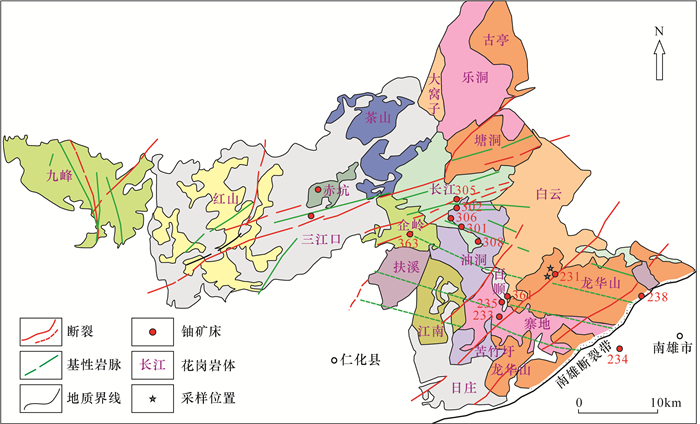
 下载:
下载:
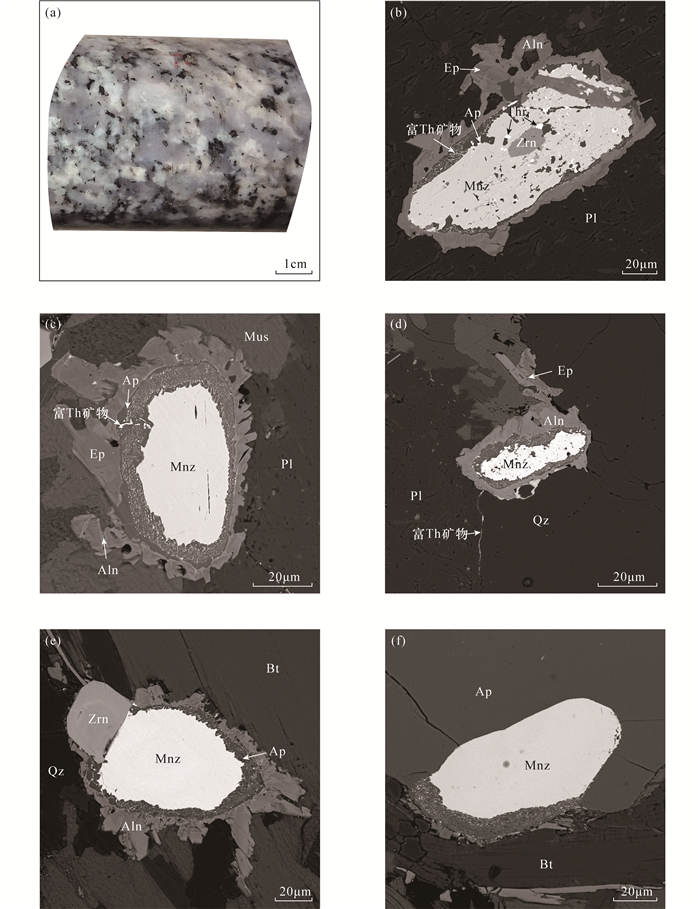
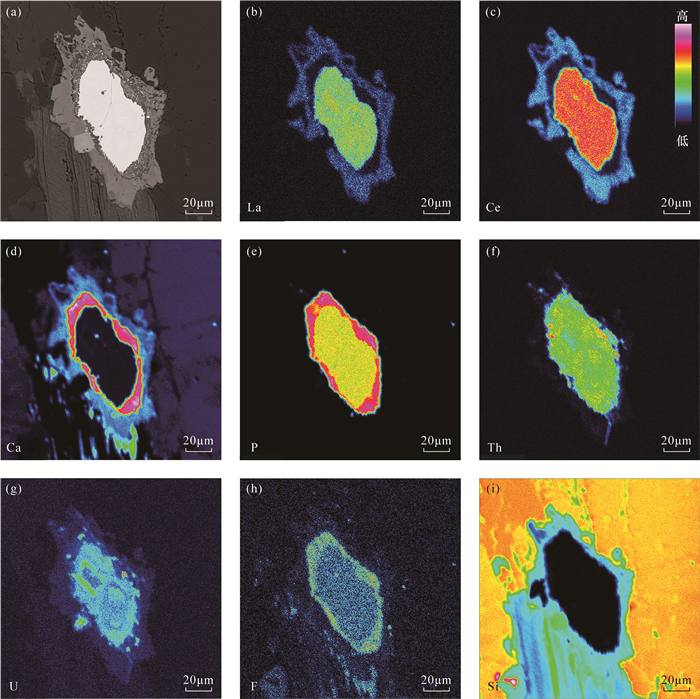
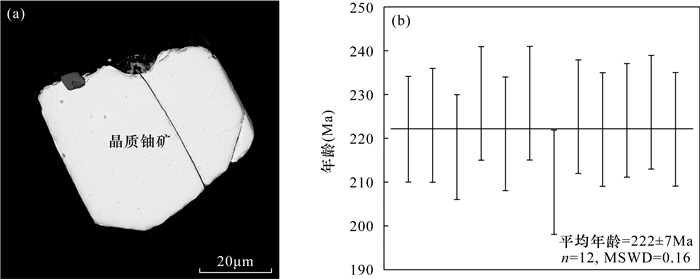
 京公网安备 11010202008159号
京公网安备 11010202008159号